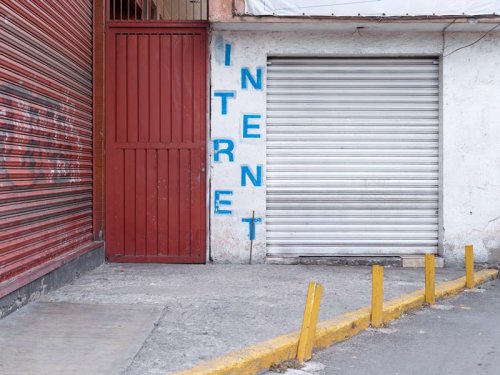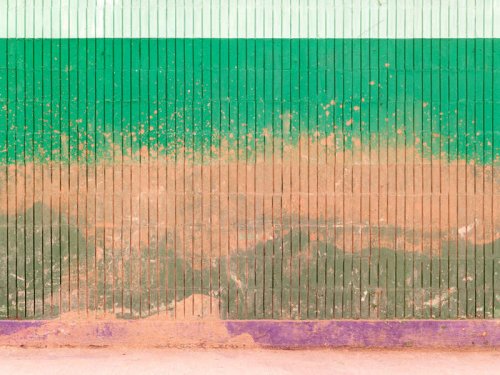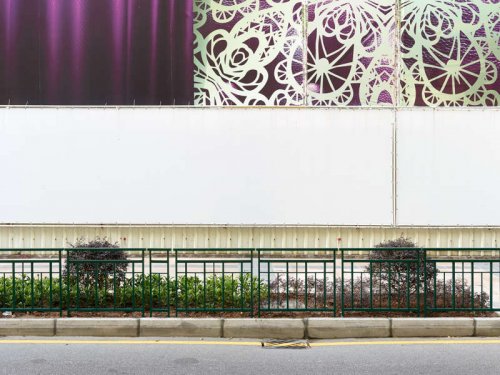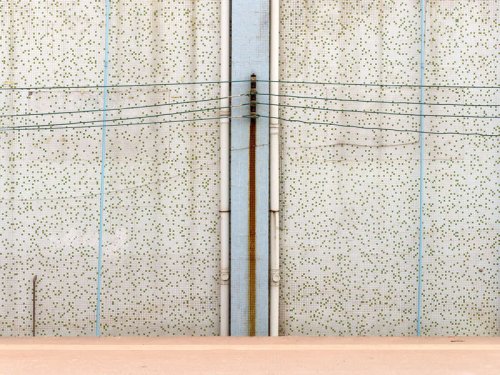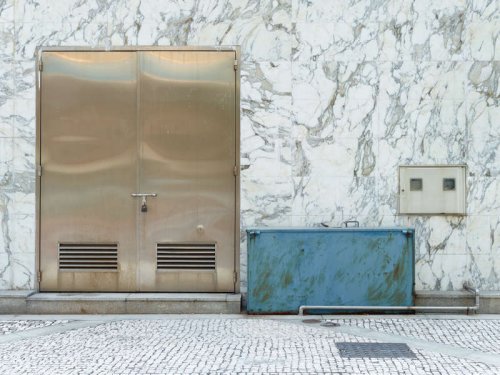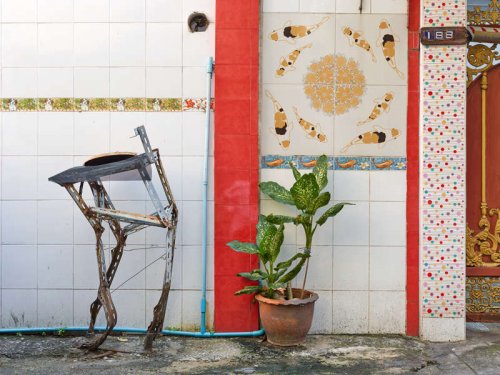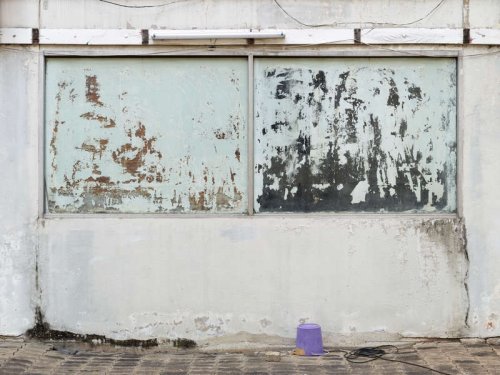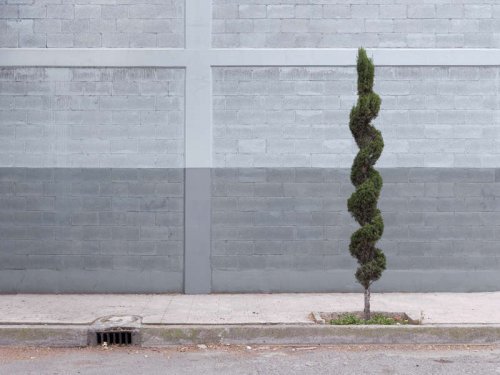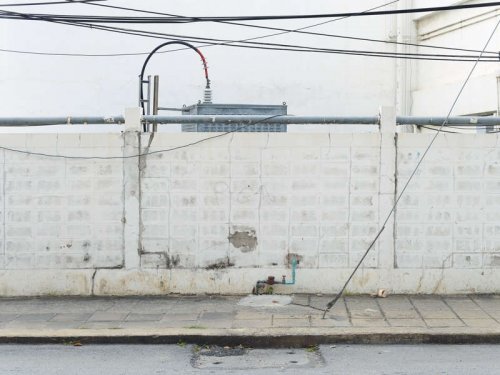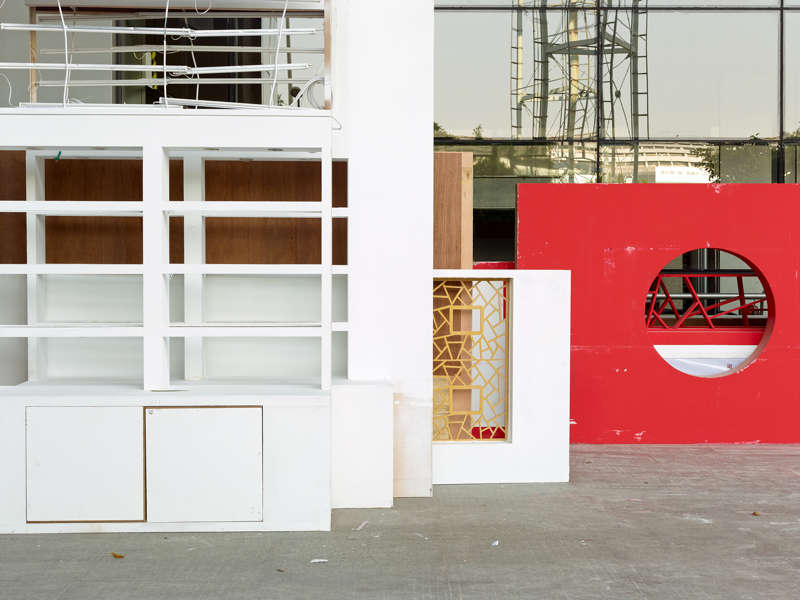
Accueil > Les rubriques > Cerveau > Horizon
Horizon
Photographies de Bert Dankaert
, et
L’exposition en cours actuellement à Bruxelles s’intitule Horizon comme le livre de plus de cent images qui l’accompagne. Nous remercions la galerie Roberto Polo de nous autoriser à publier le texte d’Alison Nordström qui accompagne ce livre ainsi qu’un choix d’images que nous avons fait.
A room full of Bert Danckaert photographs resembles a gallery of paintings. The works are large and, at first glance, many of them seem to be composed of simple organic or geometric shapes of flat colour classically arranged within the ubiquitous and intuitive photographic rectangle. We are reminded of Mark Rothko rather than Walker Evans. A closer examination reveals random remnants of human activity and its detritus with the encyclopaedic detail that only photography can render. There is no doubt that these images are rooted in the real world, but even writ small on the pages of a book, their formal aesthetic power dominates, confounding the desire for information that photographs usually satisfy. We are challenged to understand the intentions of this observant and contemplative photographer whose captured fragments of the world are both true and transcendent, yet the works themselves may encourage us to embrace their contradictions in much the same way that the artist does. The ambiguities that Danckaert finds and constructs are a primary feature of his work, but they are also an aspect of photography’s essential nature. The tension these elements create is the source of the power the photographs manifest on the wall or on the page. Though many of them are beautiful, they are not simply decorative. And though they are the result of travel, they are more about inward journeys.
Since the earliest years of the camera, photographs have served simultaneous and often contradictory functions, and have been received and used by their viewers in multiple ways, often determined by the context in which they are presented. Bert Danckaert’s photographs embody the contradictions of how and what we see. They take their power from the tensions between form and information, place and placelessness, as well as intellectual and aesthetic instincts. Danckaert is a trained artist, schooled in the history of art and shaped by the light and landscape of his native Flanders. Yet he is also a product of his time, having come of age in the increasingly globalised culture of easy travel and homogeneous environments that are familiar to most of us these days. Like the work of most photographers, Danckaert’s images record the world by capturing, stilling and isolating glimpsed details, but by doing so they change what they depict. A photograph is a document, an inventory, and an aide-memoire, but it is also an abstracting transfiguration of what it depicts into something else.
Photography has been linked to travel almost from the first days of its invention. The famed Excursions Daguerriennes of 1840–41 used daguerreotypes made by various photographers working as far afield as Alexandria, Damascus, Venice, Moscow and Niagara Falls as the basis for highly realistic engravings. The popular serial publication concentrated on the best-known views and monuments in these places, affirming with visual evidence what were already the conventional markers of place established by literature, painting and travellers’ tales. Although this reinforcement of tropes and clichés is a pattern that continues to this day in advertising, picture postcards, popular travel magazines and the work of amateurs whose aspirations are shaped by what they have already seen, it is very much the opposite of what Danckaert attempts. His images, although cursorily 05 identified with the name of the city where they were made, convey only subtle markers of place : Chinese characters on a water pipe ; a temporary roadside barrier made of bamboo held together with twine,Thai script on a door, a shrine to the Virgin of Guadalupe tucked into an outdoor corner, a public phone box branded ‘Logitel’. There are no Eiffel Towers or Empire State Buildings in this work, yet the viewer is aware of the photographer’s foreignness and isolation in the blankness of the apparently arbitrary exteriors he photographs. Bricked-up windows, closed doors and dead-end alleys surround the alien flaneur. Unmoored from his own culture, the artist is free not to judge, explain, or select his subject matter on the basis of its importance.
By titling this new series Horizon, Danckaert establishes a rich and evocative metaphor. A horizon is an illusory line, not a real one. It is unattainable, since it moves away from us as we approach it, yet it divides
everything we see into two categories : that which touches the earth’s surface and that which does not. The horizon has no materiality. It is not a thing or a place but an idea — the idea of separation between earth and sky, and as such, it represents the limit of what we can see or even imagine. Within the frame of a painting or photograph, the horizon indicates that we are looking at a landscape, and a line that suggests the distinctive low horizon of Flemish painting is present in many of this book’s views. As a symbol, the landscape evokes generations of searchers and explorers, and we speak of ‘broadening our horizons’ when we think of new learning and experiences. Horizons also mark time and suggest the future. Something ‘on the horizon’ is inevitably coming our way.
The horizon each of us sees is personal, shaped by where we stand, although we cannot completely choose or control where that is. Philosopher Peter Levine uses the idea of the horizon as a metaphor for culture, observing :
Your horizon is a function of the way the world is and how you see things. You can change, to a degree, how you look and where you stand, but you must start from somewhere that you did not choose.You have the capacity to see anything within your horizon, but you cannot see it all at once.You can describe and communicate anything within your horizon,but you cannot ever describe it all. You are aware of the horizon as a whole, but your attention focuses on objects within it.[1]
Could this not also serve as a metaphor for the photographic image ? Photographs are grounded in the real, and often in something that is not chosen but found ; what we see in them, however, is shaped by the image- maker’s decisions as well as by the settings and circumstances of our own looking at them later. A photograph is incomplete ; it is a fragment of the totality around us that we, like the photographer, experience and see. A photograph is sliced from that totality, both temporally and spatially, abstracted and removed, becoming something else. It maintains its hold on the real, but as the real transfigured, stilled, silenced and made permanent.
The low horizons in Flemish paintings are the simple actualities of the rolling flatness of Flanders’ fields, but they are also a way of seeing and a way of constructing an outdoor scene ; the word ‘landscape’ itself is a word and idea that first emerged in that part of the world. It is a painter’s term for the seeing and framing of the natural world that only later, as a verb, came to mean the grooming and shaping of the land itself. Horizons have long been the marker of exploratory travel, standing in for the wonder of possibilities that Keats evoked in his image of Cortés staring transfixed at has mostly been visualised and made in places as exotic and remote from the streets of Antwerp such as Łódz`, Guangzhou, Macau, Hong Kong, Budapest, Mexico City and Bangkok. The series does, to be sure, include three Belgian sites, one in Charleroi and two in Antwerp, but their presence serves mainly to underscore the universality of the built and barren cityscapes we inhabit and the consistent vision the photographer brings to them.
Despite this consistent vision and Danckaert’s compelling visual evidence that the world, as it develops technologically and economically, seems more and more the same, it is significant that almost all of his recent work 06 is made in places less familiar to him than his home territory of Northern Europe. Though in his earlier work he sought globalised phenomena such as Ikea parking lots and shopping malls, the work in Horizon shows a more nuanced response. Significantly, it reveals a departure from a mode of seeking the preconceived image that supports a predetermined idea ; it offers instead the mental space of the explorer, the follower of the horizon. Danckaert’s current practice is to work alone, in cities he describes as ‘randomly chosen’ and which are unfamiliar to him. He does very little research and simply walks the streets all day for several weeks in a state he compares to meditation. His subjects are not the places where he makes his photographs, but “the possibilities of a space”. His images are ultimately only about themselves. They are more made than found, using the arbitrary materials of wherever Danckaert happens to be.While reviewing these images, I found myself thinking of the first photographic efforts of
Niépce and Talbot — those blocky shapes of light through windows that are photographs of almost nothing, and of the whole world.
Most photographs transform the world’s three dimensions into the paper print’s two, but Danckaert’s images in Horizon do this more subtly than most, recording the nearly flat surface of a carelessly painted-over wall, the thin patina of green algae coating damp cement, or the ghost of a door beneath a layer of tile. Even when the surface is pronounced — a frame-filling barrier of patterned brick, or a garishly coloured geometry of trompe l’oeil plastic tarp revealed for what it is by the wrinkles and puckers of its less than perfect fit — the viewer sees flatness and is dis- oriented by it. We see differently in places where cultural clues do not distract, and the “possibilities of a space” are about seeing something for the first time, purely and without interpretation. The necessary information-free spaces of an unfamiliar place and culture facilitate this kind of innocent observation, while at the same time forcing us to look intensely and to take nothing for granted. Danckaert uses colour to support this kind of gaze. In the real world, on a real walk, colour is inseparable from the stuff around us that we read as signs ; however, in many of these photographs, each patch of colour becomes a sign in itself, asserting aesthetic meaning that aspires to be content-free.
This is an especially difficult goal to attain with photography. Even when pictures are at their most abstract, the encyclopaedic reach of the camera offers recognisable bits of the real. A wall in Poland flaunting vertical and diagonal rectangles in blue and yellow beside flat translucent washes of white on grey is all about fabrication and unintentional art making, but it is set off by a foreground of dense and specific blades of serendipitous grass, the spiky green turf spotted with fallen leaves. In another image, a rich arrangement of turquoise and white laid out as though it were a perfect ’rule of thirds’ landscape is punctuated by three bricks laid horizontally end to end, reminding us of the constant building and tearing down that characterises our cities. Contradictions like these are at the heart of what makes these pictures a success. We are forced to experience them simultaneously as form and information, and thus to change the way we see both the world and the photographs Danckaert has constructed with it. This is most noticeable in the images that show apparently random text amidst the abstract forms of walls, doors and windows. To be sure, a striped and dotted image of Bangkok emblazoned with ‘PARK’ in massive upper case is more likely to be literally read, than the incongruous あみご (a rendering of the Spanish word ‘amigo’ using a Japanese syllabary not generally used for foreign words) on a crudely painted Mexico City door. In both cases however, the ambiguity of the word and its counterintuitive placement forces us to see it as an environmental element rather than a source of information. What was script becomes decorative marks of the human hand and eye, wherever they are found, and whether or not we can decode them.
Danckaert’s practical process for making these pictures has been to immerse himself in a setting he cannot evaluate critically because it — or he — is too foreign. Rather than invent an unfamiliar place using the vo- 07 cabulary of what he already knows, Danckaert accepts its unfamiliarity as a means to seeing freshly.The disorientation of being in a place that lacks the clues and cues of a familiar culture liberates him from the associations of his brain’s usual pathways, and permits what Buddhists and others characterise as mindfulness, a special kind of awareness turned inwards to experience only the present moment. Such a state is passive, but also alert, open, curious and exploratory. It simply seeks to be aware of what is. In making these photographs, Danckaert reinforces this departure from ordinary consciousness by seeking spaces that, at the outset, are almost free of information, and then directing his camera towards them in such a way as to deny the usual touchstones of planes, negative space and the rendering of three-dimensional volume. Danckaert intentionally confuses us so that we don’t know what we are looking at, thereby, perhaps, conveying some of the state he has sought for himself. The aesthetic appeal of the work, its pleasing compositions and its evocation of landscape — without particularity of place — is what we turn to when our left brains let us down. We won’t grasp this work by thinking about it, but we may know it in another way.
Do these photographs describe culture or create it ? Do they use the stuff of culture to express a personal, emotional or intellectual response to a specific place ? The answer to these questions is a strong affirmative, and the success and effectiveness of these images is in no small part due to the way they can do so many things within a single frame. In the gallery, we approach these photographs as we do paintings, manoeuvring our bodies in relationship to them within their spheres and within our own fields of vision, seeing first the broad brushstrokes of colour and form, moving closer to sort out what actual subject matter we can discover. Our realisation that what we first perceived as an abstract form is really a representation of a particular painted wall, weathered plywood barrier, or bricked-up window adds to rather than diminishes their power.
In writing about Stephen Shore, critic Gil Blank coined the phrase “spectacularisation of the banal”[2] and it is tempting, if facile, to lump Danckaert’s photographs in the ‘pictures of nothing’ category that includes the new topographers and the vast number of artists who followed them. Danckaert’s alleys, walls and abandoned buildings are indeed unremarkable parts of the world, yet the act of photography remarks on them, not to impress but to acknowledge, without judgment, what is. Danckaert’s photographs are about nothing but themselves, yet they point beyond the frame, perhaps to the place over the horizon that mindfulness takes us to but that we cannot see.
[1] ‘Horizon as a Metaphor for Culture’. Blog post, 24 January 2014, http://peterlevine.ws/?p=13225 (accessed 6 June 2016). [2] Gil Blank, review of Stephen Shore, American Surfaces. Originally published in Issue magazine, no. 9, 2006, http://www. gilblank.com/texts/essays/amersurf.html (accessed 6 June 2016).
BERT DANCKAERT | Horizon
22 September - 20 November 2016
Rue Lebeau 8-12
1000 Brussels
Belgium
Alison Nordström is an independent writer and curator based in Cambridge, Massachusetts. Formerly Founding Director and Senior Curator of the Southeast Museum of Photography, and Senior Curator of Photographs/Director of Exhibitions at George Eastman House, she has worked extensively on both 20th century documentary photography and contemporary photographic art. She is the author of over 100 published essays on photographic topics, and has curated over 100 photographic exhibitions in nine countries. She holds the PhD in Cultural and Visual Studies.
